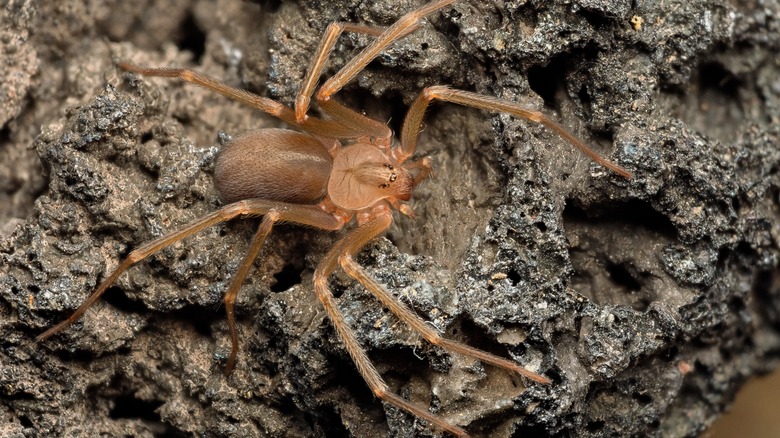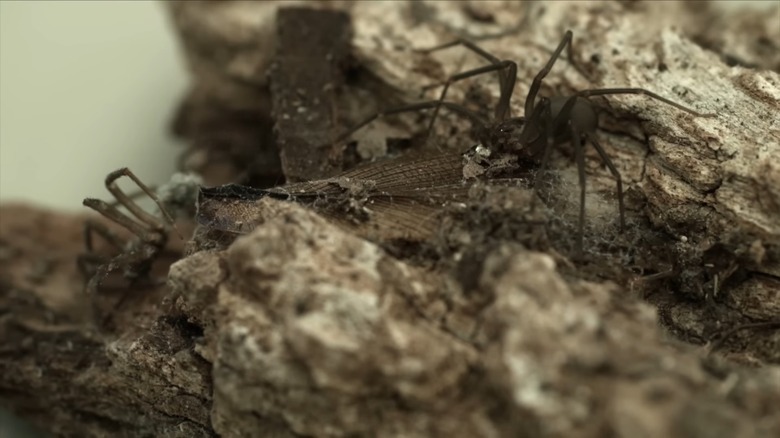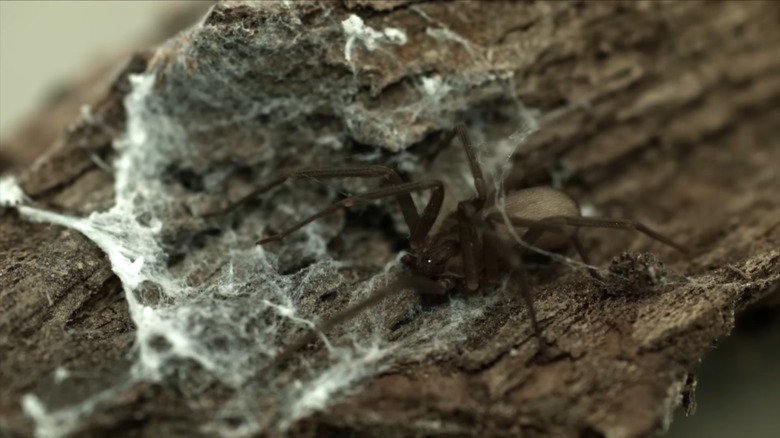Why Brown Recluse Spider Webs Look So Different (& How To Identify One In Your Yard)
Sauntering through your yard, gazing at your prized roses, breathing in their sweet scents mixed in with summer's balminess feels serene until you wander face-first into an exquisitely designed, symmetrical silken lair of the eight-legged residents (read spiders) sharing the space. But before you enter "panic mode" and drum up visceral scenarios of the U.S.'s most venomous spider, aka brown recluse spider, leaving you riddled with necrotic rashes — take a deep breath. These hanging gossamer traps are more likely the handiwork of orb weaver spiders. In the rare instance where an insect's name truly epitomizes its nature, brown recluse spiders, with their pale to chocolate-y brown bodies and hermetic instincts, thread their presence as they tiptoe on the ground. Since they don't jumpor hunger after aerial insects, they've little need to weave concentric circles, choosing instead to leave flat ribbons in their cherry-picked hunting territory, rendering their webs a unique, albeit unruly, look.
What's more, brown recluse spiders plait threads with far greater tensile strength — thanks to constant looping — than their milder, eight-eyed counterparts could ever muster, finds a 2013 collaborative study between William & Mary and the University of Oxford. Indeed, so fine is their polka-dotted silk that it doesn't even support the weight of their bodies, yet is flexible enough to extend nearly 30% without coming apart. It's believed these knots lend their webs the odd ribbon-like structure and sticky texture, enabling a better foothold, and differentiating their appearance vis-à-vis what we would usually expect of any spiderweb.
Brown recluse spiders knit retreats, not prey ensnares
Male brown recluse spiders are the nomadic huntsman of the arachnid world. They prefer venturing far and wide in search of tasty meals, including crickets, cockroaches, silverfish, and even their ilk, resting during the day in paper or wood piles. The female equivalents, however, are a different story, given that they're influenced by their motherly instincts. They spin a silken mat in dark places with little moisture and keep to it most of the time — hence also coined "retreat." In these retreats, they form their egg sacs, lacing them into the structure. Within these confines, the spiderlings are born and supported through their initial stages of molting by the recluse mother.
However, as the female recluse spiders stay close to their webs, superseding their wolf instincts, they must entice in and ambush prey (can't let themselves or the kids go hungry). This necessitates turning their silken brocades into trigger alarms — basically, tapping into vibrations — so they're alerted to the insect's presence whenever it skirts around their abode. Moreover, to safeguard themselves against any imminent threats, they turn the most covert part of their home into a thick, tubular structure (the human equivalent of a bunker), safely backing inside if the need arises.
Brown recluse spiders live in level, white webs
To know for sure whether your lawn may be attracting brown recluse spiders and harboring their webs, first, make sure your region actually aligns with their habitat range. UC Riverside's Department of Entomology and World Population Review have published indicative maps, outlining the concentrated and scant recordings of the arthropod's presence. Also, you're more likely to encounter these webs from May to August, when they're actively procreating, though sometimes it may start as early or late as February and September, respectively.
That being said, the brown recluse spider's web is no piece of art, described best as an organized mess. It'll appear as a hodgepodge of several off-white (rarely gray) ribbon threads, lending the structure a flat, tangled, irregular shape. In your yard, these messes will usually be concentrated around the most cluttered areas, such as firewood piles, stacked bricks, sunken logs, stray stones, hay bales, or free bark. Subsequently, brown recluse spiders are also likely to lurk inside your home, inhabiting dark, secluded spots, such as underneath the furniture, cabinets, or cupboards. If you chance upon the infestation early, the webs may feel sticky to the touch. However, the pastiness will eventually be lost to time because of the accumulated dust. Occasionally, the threads may be laid on too thick like a sheet, indicating the six-eyed critters deem the area as flush with insects. Under such circumstances, it's best to call in the pros to handle the spider infestation.


